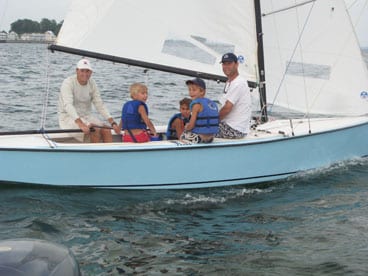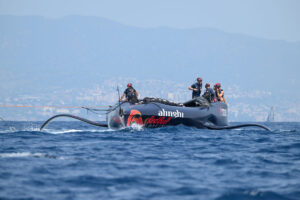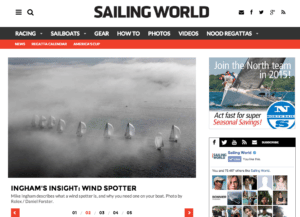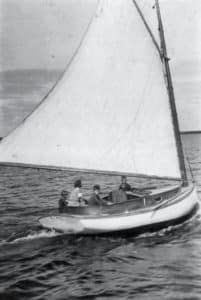
Jobson Report Dec 2011
The alarm clock rings at 0530. My father opens the bedroom door on cue. “It’s race day,” he announces. Within minutes I’ve gulped down some toast and juice, and we’re out the door. On this Saturday, about 30 small boats are forming a long tow behind the Beachwood YC’s launch. Promptly at 0600 we are on our way for the long ride up Barnegat Bay. The first race starts at 0900. There are Penguins, M Scows, Sneakboxes, Finns, Snipes, Comets, and Catboats. The sailors range in age from 8 to 90. Many boats are sailed by families.
By noon the fleet is tied up all over the place at the host yacht club. Everyone is excited, talking about the morning race, and anxiously looking forward to the afternoon contest. The scene is the essence of sailing, where sailors of all ages—fathers and their daughters, couples, brothers and sisters, and a mother and her father—are all out on the water at the same time. It’s a scene we rarely see today.
In contrast, we see parents loading up a van and trailer with several dinghies. The caravan arrives at a distant club. The youngsters go race, watched by their parents and coaches. The goal is to help the youngster prepare for a career of sailing in college, and maybe the Olympics. It’s an idyllic path to glory, but I think too many sailors are missing the real thing. The best sailing in my lifetime, and I bet, for many others, is the time spent racing with their families, and with people of different ages.
When I sit around the holiday dinner table with my daughters, discussions of sailing are never about the Opti days when I discreetly watched from the shoreline. No, the conversations are about cruising our schooner Silver Heels in Maine, or racing on our Sabre 402 Whirlwind on the New York YC Cruise. One of the best attributes of our sport is that we can participate at any age. When I was 16, I hooked up with a 52-year-old champion named Sam Merrick. I spent five great summers racing with Sam on his E Scow. During these years I developed into a tactician, and the experience eventually helped me gain a berth in the America’s Cup. And you can bet the lessons learned racing with Sam extended far beyond sailing. Now, many years later, I can see why he raced with teenagers. He learned from us, as well.
I recently received a letter on this topic from Peter Huston, a passionate sailor from upstate New York. His message was right on target: “The reason the Buffalo Canoe Club has always turned out such good sailors, who excel in a variety of classes, is because there has always been a ‘mentor-apprentice’ system of nurturing talent, from a very early age.” Huston credits Olympian Jack Mathias (Flying Dutchman-1976) for developing the “mentor-apprentice” concept. “The core for the last 70 years has been the Lightning class. It’s always been the norm that younger people sail with older people, sometimes families, more often crews put together from a variety of friends, families, and kids from sailing class.”
Champion Lightning sailors David and Jody Starck race with their kids Sabrina (5) and Jamie (3). “Jody is very good about bringing the right snacks and preaching fun, fun, fun,” says David Starck. “Every time I’m on the water, they remind me, through their questions and actions, why I love this sport so much. We are teaching them all the time, and they are teaching us, too.”
There are many examples how family sailing experiences help develop champion sailors. I recall sailing in an Etchells regatta many years ago, and our toughest competitor was Buddy Melges. His two teenage sons, Hans and Harry, were crewing for him. Buddy could’ve easily sailed with any champion crew he wanted, but he preferred racing with his boys. Both later became superb sailors in their own right.
Bill Campbell, past commodore of San Diego YC, also raced E Scows and other boats with his sons and wife. Both boys went on to be top collegiate sailors, and Andrew competed in the Laser in the 2008 Olympics. “As a family, we interact on the boat, and that carries over to the after-race activities and life at home,” says the elder Campbell.
Olympian Sally Barkow still races with her parents and siblings in scows in the Midwest. The lessons learned racing together and against each other have been a major asset for Barkow in handling her international sailing campaigns. “I learned almost everything there was to learn about racing while competing with my brothers,” she says. I bet the sibling rivalry helped all of them immensely. They are formidable competitors when they race together.
Successful family racing teams also extend into big-boat racing. Last summer, Rives Potts, rear commodore of New York YC, raced the Transatlantic Race and Fastnet Race with his two sons. There were four other fathers aboard, three had their sons with them, and one brought his daughter. They won their class in the Fastnet Race.
One of America’s most prominent sailing families is the Johnstone clan, curators of the many J Boat classes. “We have three generations of sailors on the same sports team,” says Jeff Johnstone. “Racing with your family is one of the most important things you can do. Every part of it is an adventure.” At a recent race week, their J/80 crew included Jeff, age 50, his 21-year-old daughter, and his father, Rod, who is 73. They finished second to John Stork, sailing—as usual—with his two sons and daughter.
In addition to family sailing, I find that classes that offer a junior championship tend to be the most enduring. In the 1960s, the Penguin Class held an annual International Junior Championship. It was special meeting young people my age from South America and Canada. After the junior regatta, many of us would crew for adults in the Internationals. It was a terrific learning experience. Lightning champ Jim Carson, from the Metedeconk (N.J.) YC, started a Junior North Americans in the early 1970s. This inspired the late Larry McDonald Sr., from Ontario, Canada, to start a Junior Lightning World Championship. These events help the class bring in new people and keep them active in sailing.
Another Lightning family helped brothers Greg and Matt Fisher develop into all-star sailors. “I’d like to think that sailing with my father, brother, or my kids really underscored the value of a strong family tie and what it means to sail as a team,” says Greg, a champion in numerous one-design classes. “Together we learned what it took to win, and how to handle losing.”
After vibrant junior sailing careers, many young adults disappear from sailing. In my view, many of these youngsters are pushed too hard at an early age. Certainly, learning as a group is important and helpful, but the larger goal should be racing with adults. There is great satisfaction watching a young sailor eventually becoming the fastest helmsman. The experiences of the aforementioned sailors points to a common denominator in sailing: all of them were inspired by racing with their parents and siblings and used these experiences to make family sailing a priority with their own kids.
It’s important for parents to provide opportunities for young sailors. The greatest gift for everyone is to participate as a team.
I’m happy to report that our first (of many, I hope) grandson arrived in May. During a recent visit, I got my turn to hold five-week-old Declan Michael. His parents and grandmother were all watching and taking pictures. I asked the alert young man, “Would you like to go sailing?” And for the first time in his life he broke into a big smile. We all laughed, but deep down I resolved that we would sail together, and that my time watching from the seawall would be minimal.









